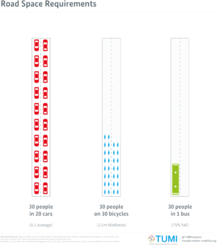The Cities Portal

A city is a human settlement of a notable size. The term "city" has different meanings around the world and in some places the settlement can be very small. Even where the term is limited to larger settlements, there is no universally agreed definition of the lower boundary for their size. In a more narrow sense, a city can be defined as a permanent and densely settled place with administratively defined boundaries whose members work primarily on non-agricultural tasks. Cities generally have extensive systems for housing, transportation, sanitation, utilities, land use, production of goods, and communication. Their density facilitates interaction between people, government organizations, and businesses, sometimes benefiting different parties in the process, such as improving the efficiency of goods and service distribution.
Historically, city dwellers have been a small proportion of humanity overall, but following two centuries of unprecedented and rapid urbanization, more than half of the world population now lives in cities, which has had profound consequences for global sustainability. Present-day cities usually form the core of larger metropolitan areas and urban areas—creating numerous commuters traveling toward city centres for employment, entertainment, and education. However, in a world of intensifying globalization, all cities are to varying degrees also connected globally beyond these regions. This increased influence means that cities also have significant influences on global issues, such as sustainable development, climate change, and global health. Because of these major influences on global issues, the international community has prioritized investment in sustainable cities through Sustainable Development Goal 11. Due to the efficiency of transportation and the smaller land consumption, dense cities hold the potential to have a smaller ecological footprint per inhabitant than more sparsely populated areas. Therefore, compact cities are often referred to as a crucial element in fighting climate change. However, this concentration can also have significant negative consequences, such as forming urban heat islands, concentrating pollution, and stressing water supplies and other resources. (Full article...)
Selected city -

Havana (/həˈvænə/; Spanish: La Habana [la aˈβana] ; Lucumi: Ilú Pupu Ilé) is the capital and largest city of Cuba. The heart of the La Habana Province, Havana is the country's main port and commercial center. It is the most populous city, the largest by area, and the second largest metropolitan area in the Caribbean region. The population in 2002 was 2,137,847 inhabitants, and its area is 728.26 km2 (281.18 sq mi) for the capital city side and 8,475.57 km2 for the metropolitan zone.
Havana was founded by the Spanish in the 16th century. It served as a springboard for the Spanish conquest of the Americas, becoming a stopping point for Spanish galleons returning to Spain. Philip II of Spain granted Havana the title of capital in 1607. Walls and forts were built to protect the city. (Full article...)Did you know -
- ... that antimonumentas in Mexico, like those in Guadalajara, in Morelia, or in Mexico City, are installed by protesters to demand justice for women who suffer from violence in the country?
- ... that the Cartier Building in New York City was purchased in exchange for $100 and a necklace?
- ... that Lever House, slated for replacement with a larger building in the 1980s, was protected as a New York City landmark with a one-vote majority?
- ... that George Balanchine choreographed his ballet Scherzo à la Russe for the New York City Ballet's Stravinsky Festival, a tribute to the composer after his death?
- ... that Henry Clay Frick would not take World War I as an excuse for delays in the construction of his New York City house?
- ... that Donald H. Elliott's efforts as the director of New York's planning department helped change the city's skyline?
Related portals
Related WikiProjects
Atlanta (/ætˈlæn(t)ə/ at-LAN-(t)ə) is the capital and most populous city in the U.S. state of Georgia. It is the seat of Fulton County, and a portion of the city extends into neighboring DeKalb County. With a population of 510,823 living within the city limits, Atlanta is the eighth most populous city in the Southeast and 38th most populous city in the United States according to the 2020 U.S. census. It is the core of the much larger Atlanta metropolitan area, which is home to more than 6.3 million people (2023 estimate), making it the sixth-largest U.S. metropolitan area. Situated among the foothills of the Appalachian Mountains at an elevation of just over 1,000 feet (300 m) above sea level, Atlanta features unique topography that includes rolling hills, lush greenery, and the densest urban tree coverage of any major city in the United States.
Atlanta was originally founded as the terminus of a major state-sponsored railroad, but it soon became the convergence point among several railroads, spurring its rapid growth. The largest was the Western and Atlantic Railroad, from which the name "Atlanta" is derived, signifying the city's growing reputation as a major hub of transportation. During the American Civil War, it served a strategically important role for the Confederacy until it was captured in 1864. The city was almost entirely burned to the ground during General William T. Sherman's March to the Sea. However, the city rebounded dramatically in the post-war period and quickly became a national industrial center and the unofficial capital of the "New South". After World War II, it also became a manufacturing and technology hub. During the 1950s and 1960s, it became a major organizing center of the American Civil Rights Movement, with Martin Luther King Jr., Ralph Abernathy, and many other locals becoming prominent figures in the movement's leadership. In the modern era, Atlanta has remained a major center of transportation, with Hartsfield-Jackson International Airport becoming the world's busiest airport by passenger traffic in 1998 (a position it has held every year since, except for 2020), with an estimated 93.7 million passengers in 2022. (Full article...)Selected article -

The compact city or city of short distances is an urban planning and urban design concept, which promotes relatively high residential density with mixed land uses. It is based on an efficient public transport system and has an urban layout which – according to its advocates – encourages walking and cycling, low energy consumption and reduced pollution. A large resident population provides opportunities for social interaction as well as a feeling of safety in numbers and "eyes on the street". It is also arguably a more sustainable urban settlement type than urban sprawl because it is less dependent on the car, requiring less (and cheaper per capita) infrastructure provision (Williams 2000, cited in Dempsey 2010).
Achieving a compact city does not just mean increasing urban density per se or across all parts of the city. It means good planning to achieve an overall more compact urban form:
The compact city model, ideally, creates benefits that are attractive to modern urbanites. The desired benefits include shorter commute times, reduced environmental impact of the community, and reduced consumption of fossil fuels and energy. However, research on compact cities from around the globe suggests that these outcomes are not guaranteed. To make matters worse, the design of the cities is limiting residents' access to green space and reasonable views. For the compact city model to gain in popularity, it is necessary to review both their pros and cons. (Full article...)Governments of sprawling cities can take many actions to seek a more compact form, often also involving higher densities. Other cities, such as Cairo, with large, dense slum areas, are responding by reducing urban densities in core areas. In either case, limiting outward urban expansion can be combined with more efficient use of land resources and more effective protection of natural resources. City growth can be physically limited in this way through legislated urban growth boundaries, non-urban green belts, and the quarantining of development in certain areas.
General images -
Topics
List articles
Subcategories
Associated Wikimedia
The following Wikimedia Foundation sister projects provide more on this subject:
-
Commons
Free media repository -
Wikibooks
Free textbooks and manuals -
Wikidata
Free knowledge base -
Wikinews
Free-content news -
Wikiquote
Collection of quotations -
Wikisource
Free-content library -
Wikiversity
Free learning tools -
Wiktionary
Dictionary and thesaurus







































